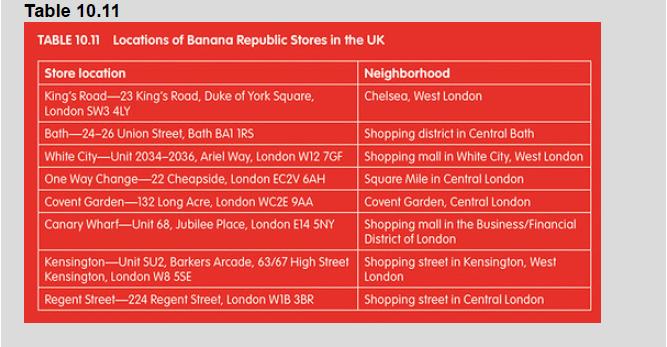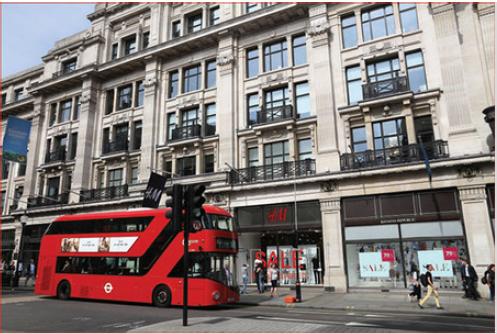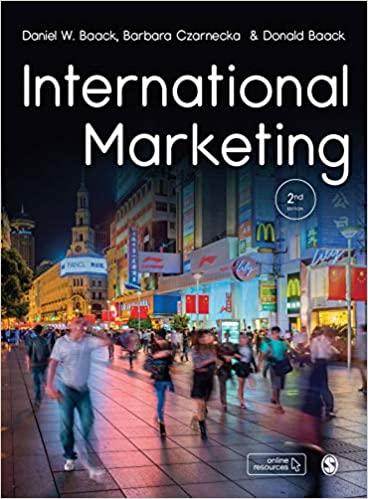U.S. clothing and accessories retailer Banana Republic, worn by Olivia Palermo and the Duchess of Cambridge, announced
Question:
U.S. clothing and accessories retailer Banana Republic, worn by Olivia Palermo and the Duchess of Cambridge, announced in 2016 that after eight years on British shores it was closing all of its eight UK stores and British consumers would only be able to buy the brand’s clothes online. Banana Republic is owned by an American multinational corporation, Gap Inc. It was founded in 1978 by two entrepreneurs and bought by Gap Inc. in 1983. The company offers clothing for men and women in a style described by the company as “versatile,
contemporary classics, designed for today with style that endures.”37 Banana Republic maintains more than 600 stores in North America, ten stores in Europe, seventy stores in Asia, thirteen in the Middle East, seven in South America, and five in Africa.38 The brand arrived in the UK in 2008 just after the financial crisis, and closed all of its stores by the end of 2016. According to market analysts many external and internal factors contributed to its failure.
Consumers became more cost-conscious after the financial crisis and either turned to cheap fashion such as Primark, did not buy clothes for some time, or waited for price discounts. Many consumers moved online to shop for fashion with major competitors offering a wide range of clothes and accessories at competitive prices and convenient and cheap delivery options. The product offering did not live up to the expectations of British consumers who have switched from shopping for clothes to spending money on experiences such as holidays or dining out (Daneshkhu, 2016; Daneshkhu and Vandevelde, 2016).
Analysts suggested that the pricing and promotion strategy did not take into account the nature of the British market and local consumer habits. The brand entered the British market by opening a store on one of the most popular shopping streets in the heart of London, Regent’s Street. The company intended to compete with other brands that were present in the crowded clothing market.
The promotional and pricing strategy did not however support the intended positioning as a premium brand. Sales promotions damaged the brand’s image as consumers were aware of discounts and withheld purchases until the expected discount was offered (Strachan, 2016).
British consumers commented that Banana Republic offered “some good solid styles” but “they tried to bring too much American style here which didn’t work”
and were overpriced compared to competitors such as Zara. There were almost no stores outside of London (Table 10.11) which was disappointing to some consumers and did not help to build Banana Republic’s brand awareness.
One of Banana Republic’s strategic priorities is to further develop an omnichannel shopping experience for customers through the integration of store and digital shopping channels. This could be an opportunity for the brand to raise and maintain brand awareness in international markets, but is also seen as a challenging objective given that competitors are also striving to integrate off-line and online channels.
Banana Republic’s current strategies include pursuing selective international expansion in a number of countries around the world through a number of channels. The company intends to open additional stores outside of the United States, and continue to grow online sales internationally. These plans are ambitious and need to be carefully considered and executed because the company has limited experience operating or franchising in some of the intended international locations. In many markets Banana Republic would face major, established competitors. In addition, in many of these locations, the real estate, employment and labor, transportation and logistics, regulatory, and other operating requirements differ dramatically from those where Banana Republic has more experience. Consumer tastes and trends may differ in many of these locations as well and, as a result, the sales of the products may not be successful or result in the margins the company anticipates. If international expansion plans are unsuccessful or do not deliver an appropriate return on the planned investments, the operations and financial results could be materially, adversely affected
Questions
1. Why did Banana Republic failed in the UK?
2. Compare the product offering of Banana Republic in the UK to the product offering in the United States and Canada. Do you think the brand would have been more successful in the UK with a different product offering?
3. If Banana Republic was to reenter the UK, what should the brand do differently in order to be more successful?
4. If adaptation of the marketing mix is recommended, which aspects of the marketing mix would you recommend Banana Republic to adapt to the British market and in what ways?
5. Do you think that Banana Republic should continue to offer online shopping to British consumers and how should the brand capitalize on this should they wish to reenter the market in the future?
6. What other countries would you recommend for Banana Republic to consider next for their international expansion plans, and what product acceptance challenges would the company face in those countries?
Step by Step Answer:

International Marketing
ISBN: 9781506389219
2nd Edition
Authors: Daniel W. Baack, Barbara Czarnecka, Donald E. Baack





